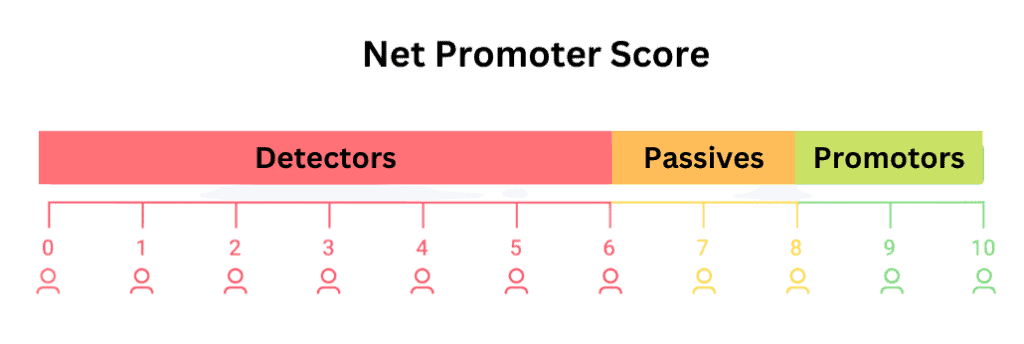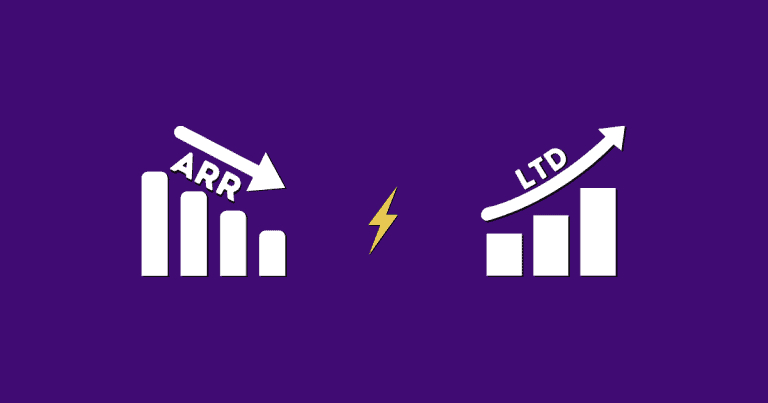Everything You Need To Know About SaaS Net Promoter Score (NPS)
Do you want to get better at marketing your SaaS Solution? If so, then you should check out the SaaS Net Promoter Score (NPS).
The NPS is a powerful tool that helps businesses measure their customer relationships.
This free tool measures consumer loyalty and helps business improve service delivery. By knowing whether customers want to stay or leave, businesses can better target marketing campaigns.
SaaS business often get asked whether they should focus on their customer retention or acquisition strategies.
The marketing buzzword of today is Customer Retention Marketing, which means keeping existing customers happy. While this sounds great in theory, it can also mean sacrificing growth opportunities for new accounts.
Net Promoter Score is designed to gauge consumer satisfaction and loyalty. It allows businesses to determine whether they are providing a good or bad experience and to see where improvements might be needed.
👉The idea behind NPS is simple: customers who are promoters and detractors are equally important.
It is used to measure overall customer satisfaction and identify opportunities for improvement.
You need to consider several things before you start using the NPS method
First, you need to identify your ideal customer and understand their experience with your brand.
Next, you need to figure out the NPS level at which your current customer base falls.
Finally, you’ll want to decide whether or not you want to try applying the NPS approach to your entire organization.
There are three primary reasons to track and manage NPS
1. Customer Satisfaction – Knowing whether customers are satisfied with your services helps you understand their expectations and gauge your success.
2. Business Growth – NPS scores correlate strongly with future revenue growth, indicating that they are important indicators of overall business health.
3. Marketing Campaign Success – If your marketing campaign has high NPS scores, it means that you are successfully reaching out to your target audience and bringing them back to your site or landing page.
Why NPS is important?
The Net Promoter Score measures customer satisfaction and loyalty through survey data from customers who had previously purchased or consumed the company’s services.
It is a simple way to measure customer loyalty and assess the overall health of the relationship between a brand and its consumers.
A Net Promoter Score (NPS) provides businesses with valuable insights into their key stakeholders such as employees, partners, suppliers and even competitors.
According to Gartner, organizations using the NPS methodology can identify opportunities for improvement and increase sales revenue.
The higher your NPS, the better your chances of winning new clients and retaining existing ones. In other words, NPS helps businesses improve their bottom line.
1️⃣ It measures customer loyalty
“Customer loyalty” has become a major focus of marketing and management strategy today.
As consumers demand new experiences and services, businesses face challenges in finding ways to retain existing customers while attracting new ones.
The Net Promoter Scale was designed to provide insights into consumer attitudes toward a brand, a product, or a service.
Most SaaS businesses want their customers to be loyal, but they don’t know how to measure it.
Net promoter score (NPS) is a tool that helps determine whether or not a brand is meeting its customers’ expectations.
A positive NPS indicates that the company has satisfied existing customers and gained new ones.
Conversely, a negative NPS indicates that the current customers aren’t satisfied and would rather go elsewhere. Business with low scores should consider ways to improve them.
As businesses become more globalized, they realize the importance of retaining their customer base. In fact, NPS helps businesses identify and focus on their greatest strengths and weaknesses.
2️⃣ It is easy and efficient
It’s easy and straightforward. It has no learning curve. It is easy to use and cost-effective.
A single item survey that takes less than 30 seconds to complete. This is what makes it perfect for customers.
Running an NPS survey is one of the easiest things to do. You can collect customer feedback by using any number of methods including using an online questionnaire, emailing them, or asking for their opinion through a customer satisfaction form. It doesn’t just benefit your customers, but it benefits your business too.
3️⃣ Identification of unhappy customers
Net Promoter Score (NPS) is an effective tool for measuring customer satisfaction. NPS calculates how likely a customer is to recommend a company over other similar business. Businesses that rank high on the NPS scale tend to experience higher levels of loyalty from their customers.
There are various ways to identify potential unhappy customers. The Customer Experience Management (CEM) module helps businesses measure customer satisfaction across multiple channels.
One of the key metrics is Net Promoter Score (NPS), or the number of promoters minus detractors.
NPS scores range from -100 to +100, where negative numbers indicate detractors and positive numbers indicate promoters. Businesses can also calculate their Net Promotor Index (NPI).
Businesses often focus only on customer retention strategies instead of focusing on building loyal customers who will become promoters.
How important is customer satisfaction in the overall success of your company?
Customer satisfaction is one of the most important metrics for businesses. The key to improving customer experience is to assess their opinions and feelings about the company.
There are several ways to gauge customer satisfaction
One way is through surveys where customers are asked questions such as whether they are satisfied with services rendered by the company.
Another method involves conducting focus groups where customers discuss their expectations from business and the experiences they had.
4️⃣ A single metric for your entire business
Net Promoter Score (NPS) is widely recognized as a single metric for measuring customer satisfaction.
Businesses with high scores tend to enjoy higher retention rates, stronger financial performance, and greater employee productivity.
Businesses often measure their success using multiple metrics such as sales, profit margins, revenue growth, etc. NPS helps them assess and improve each aspect of their businesses.
With NPS, companies get feedback from customers regarding their experience with the brand. They then use this information to improve their services and products.
This method allows them to identify areas where they are falling short and provide solutions to these problems.
5️⃣ It boosts referral marketing
Referral marketing is a powerful way to generate new leads and sales at the same time. In fact, over 50% of B2B companies rely solely or primarily on referrals for customer acquisition.
Unfortunately, they often don’t fully realize its potential because they don’t know how to effectively measure their success.
That’s why the Net Promoter Score (NPS) – a simple tool that measures client loyalty.
You can boost your NPS by using effective communication tools such as email newsletters, social media posts, and webinars. These methods allow you to build trust, establish rapport, and provide valuable information that keeps your clients engaged.
If you wonder what getting and keeping the right employees has to do with getting and keeping the right customers, the answer is everything.
Fred Reichheld
According to Fred Reichheld, businesses who had high Net Promoter Scores (the percentage of promoters minus detractors divided by total number of respondents) outperformed their competitors by 40%.
Since then, NPS has become a powerful tool for measuring customer loyalty and improving marketing ROI.
🔹Customers don’t care how much you spend on advertising – they only care about the quality of service you provide them.
🔹Customer feedback is invaluable. Use it to improve customer experience and build better relationships.
🔹Build trust with your audience by being transparent and honest.
How to measure Net Promoter Score (NPS)?
Net Promoter Score or NPS measures customer loyalty, which has become essential for the survival of companies today.
By measuring customer retention rate, companies can determine whether they should continue offering services to current customers or try to attract new customers.
With a score between -100% and 100%, NPS enables businesses to identify opportunities to increase sales and retain customers. If your company has never used the NPS before, here’s everything you need to know about its benefits and calculations.
Can you guess why NPS scores are so important? If you guessed customer satisfaction, then you’d be wrong.
In reality, NPS scores are used to measure loyalty, trust, advocacy, and other aspects of a company or brand. The higher the score, the better.
NPS scores are calculated using data from surveys conducted by independent research firms.
They provide valuable insights into what customers really think about their experience with a particular company, product or service.
Businesses use these insights to improve their products, services, marketing campaigns, and overall performance.
How to calculate Net Promoter Score (NPS)
You can calculate your NPS by subtracting the percentage of detractors from the percentage of promoters.

Net Promoter Score (NPS) is a metric that measures customer loyalty and satisfaction across an organization or brand.
NPS helps businesses determine their current level of customer advocacy and identify opportunities for improvement. This is often referred to as “customer retention”.
You may already know that NPS is calculated using three questions. The answers determine whether a person is a “promoter,” “detractor,” or “passive.”
Businesses typically aim for an average score around of 7, although higher numbers indicate better performance.
It’s not hard at all to calculate NPS. You need to rate the survey from 0-10.
“Promoters” give high scores whereas detractors provide low ones. Businesses usually focus on improving the scores of promoters rather than detractors.
This is because the former group represents loyal customers who are willing to spread good word about your brand. On the other hand, those with low scores are likely to leave your services, leaving no room for improvement.

Your goal should therefore be to get your customer base to become Promoters instead of detractors.
To calculate your company’s Net Promoter Score, simply take the total number of promoters divided by the total number of respondents.
For example, if 100 respondents gave positive feedback and 50 responded negatively, then your NPS is 50%.
Similarly,
To calculate your NPS, take the average of both numbers. Then add 100% minus the percentage of detractors. This gives you the total number of promoters. Divide it by 100%, and you get your NPS. The lower the number, the worse your performance.
➡️ Customer Satisfaction Survey (CSAT)
Customer Satisfaction Survey (CSAT) is a simple survey tool that helps businesses measure their customers’ satisfaction level.
The data collected from CSAT help businesses prioritize areas where they need to focus.
They also allow you to uncover details regarding the reasons why consumers might be dissatisfied with your services or products. This information can then be used to create new strategies and plans to improve certain aspects of your business.
How does Customer Satisfaction (CSAT) differ from Net Promoter Score (NPS)? What makes each metric valuable? Why should businesses care? And how can they get started?
The Net Promoter System (NPS) is a simple way to measure customer loyalty and advocacy at scale.
Businesses around the globe turn to the NPS methodology because it helps them identify their strongest advocates and detractors—which leads to better decision-making and improved marketing effectiveness.
CSAT and NPS both provide metrics to measure customer satisfaction and brand perception. However, the difference between them lies in their purpose.
While CSAT measures overall satisfaction, NPS focuses on whether customers would recommend a company to others.
Wrapping Up
Net Promoter Score is a crucial metric for the SaaS industry. It measures customer happiness and loyalty as well as provides valuable insights into the degree of word-of-mouth marketing your product has generated.
By tracking customer satisfaction scores (NPS) closely, your SaaS service can use the data to add more value to your customers’ lives.




